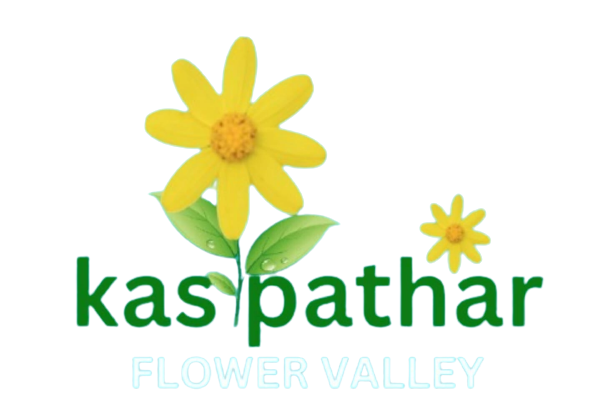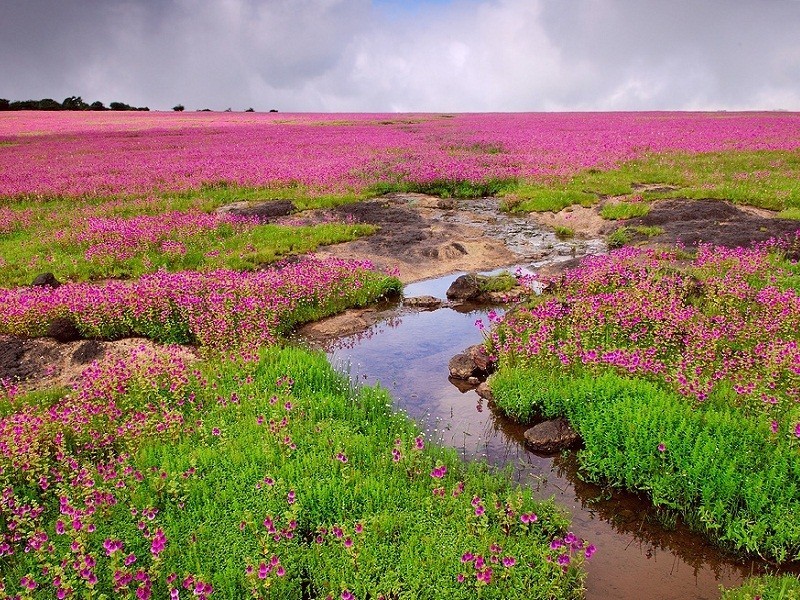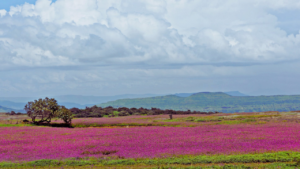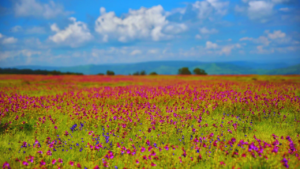Introduction
Looking at the western part of India, specifically in the Satara district of Maharashtra, you’ll find the Kaas Plateau, or Kaas Pathar as it’s locally known. This biodiversity hotspot, part of the Western Ghats, a 1600 kilometre-long mountain range covering 140,000 square kilometres of the Indian landscape, has now been designated as a UNESCO World Heritage Site. Along with 39 other sites, in 2012 by the World Heritage Committee in Saint Petersburg, Russia.

Biodiversity of Kaas Pathar | Kaas Plateau
Concerning biodiversity hotspots, Kaas Plateau in Maharashtra, India is one of the best examples. Nicknamed the ‘Valley of Flowers of Maharashtra’, this volcanic plateau is 1,000 hectares of ancient rocks that explodes into a kaleidoscope of colours every year, in the beginning of the monsoon season, from September to October.
This plateau is basically a haven for plant researchers, photographers, and nature lovers, who get to witness over 850 species of flowers, including orchids and carnivorous plants.
In short, the Kaas Plateau has a very high degree of endemism and its visually stunning, and should be visited at least once in your lifetime.
How To Reach Kaas Pathar
By Air: The nearest airport is Pune Airport, which is about 140 km away, and has regular flights to other cities in the country, when coming to Kas Pathar. Coming from the airport, you can take a bus or taxi to Satara.
By Train:Satara Railway Station is the closest railway station to Kas Plateau and is well-connected to the rest of India, so you can take the train to Satara station.
Perhaps the Koyna Express from CST in Mumbai, then, hop on a bus or auto rickshaw to Satara bus station, from where a bus will take you to Bamnoli village, where Kas Plateau is located.
Self-driving:If you are coming from another state, you could also drive to Kas Plateau via the well-developed roads that connect this region to the rest of India. The monsoon season from August to October is considered the best time to visit Kaas Pathar and is also the time when the plateau is carpeted with vibrant wildflowers.
How to reach Kas Pathar from Pune
To reach Kas Plateau by bus from Satara city, you can follow these general steps:
Reaching the Big City: The Kas Plateau is located near Satara in the Indian state of Maharashtra. You may need to first reach one of the major cities in Maharashtra, such as Mumbai or Pune.
Getting to Satara: Satara is the closest major city to the Kas Plateau. From Mumbai or Pune, you can take a bus or train to Satara.
Local buses to Kas Plateau:Satara is the closest major city to your destination, when heading to the Kas Plateau. Coming from Mumbai or Pune you’ll find buses and trains to Satara, and then need to get a local bus, taxi, or autorickshaw to reach the plateau.
Confirm routes and timetables: Local bus services to the Kas Plateau are not fixed, so check with the bus station or ask a local for the best way to get there. Many travel agencies in Satara offer day trips to the Kas Pathar, including transportation and guided tours. A great option if you don’t want to figure out the local transport system yourself.
Consider a travel agency and plan: You should time your trip to the Kas Plateau for the flowering season, which generally runs from August to October, and may vary year to year, so check in advance for the best times to visit.
It’s a good idea to check on the latest transportation information and routes, as they can be subject to change, when planning your trip to Kas Plateau. You should also be prepared for possible delays and road closures, and in particular monsoon road conditions can be dangerous.
Safety is your top priority, you must check with the local government, or your tourist information centre to get the latest updates.

Kaas Plateau is a UNESCO World Heritage site and a biodiversity hotspot situated at 1200 metres above sea level, roughly 25 kilometers west of Satara in Maharashtra. Its orchids and other flowers make it look stunning in this season, and the attractions around Kaspartar don’t miss out.
Coming from Hyderabad in Andhra Pradesh, you’re able to travel to Kas Plateau by train or bus to Satara and then hit the road. From Satara you can easily get to Kas Plateau via Shendre and Satara Yevteshwar, Pachwad and Kudal Medha.
Conclusion:
You’re in for a real treat, when visiting Kas Pathar Distance. The breathtaking floral paradise will be waiting for you, as well as the area’s magnificence, just be sure to plan, prepare and be responsible. The Kas Pathar plateau will leave you in awe with its sensory delights
How to visit Kaas Pathar from Pune?
The nearest airport to Kas Pathar is Pune Airport, 145 km from Kas Pathar. You can reach Kas Pathar from Pune Airport by taxi, cab or bus. You can take the Pune-Bengaluru Expressway (NH4).
How do I reach Kaas Pathar from Satara Station?
From Satara railway station, take a bus or auto rickshaw to Satara ST depot. There, inquire at the counter and ask for the timings of the Bamanoli and Tetli buses going to Kas. You can reach Kas Plateau by catching these buses or by shared jeep or auto.
How long is Mahabaleshwar from Satara?
Travel time from Mahabaleshwar to Satara by road is 1:49 hours
Can I drive from Pune to Kas Plateau?
The driving distance between Pune to Kas Plateau Reserved Forest is 133 km. It takes approximately 2h 1m to drive from Pune to Kas Plateau.
How do I reach the Kaas Plateau using public transportation from Mumbai?
Trains like Koyna Express and Sahyadri Express connect Mumbai to Satara. Alternatively, you can take a State Transport (ST) bus from Mumbai to Satara. Some private bus companies also provide transportation services between the two cities.
For More Updates:-
Google local guide: local expert guide
Facebook:- Kas Pathar Flower Valley
WhatsApp channel:- Kas Pathar Channel
Twitter :- Kaas Pathar Valley
Instagram :- Kaas Plateau




